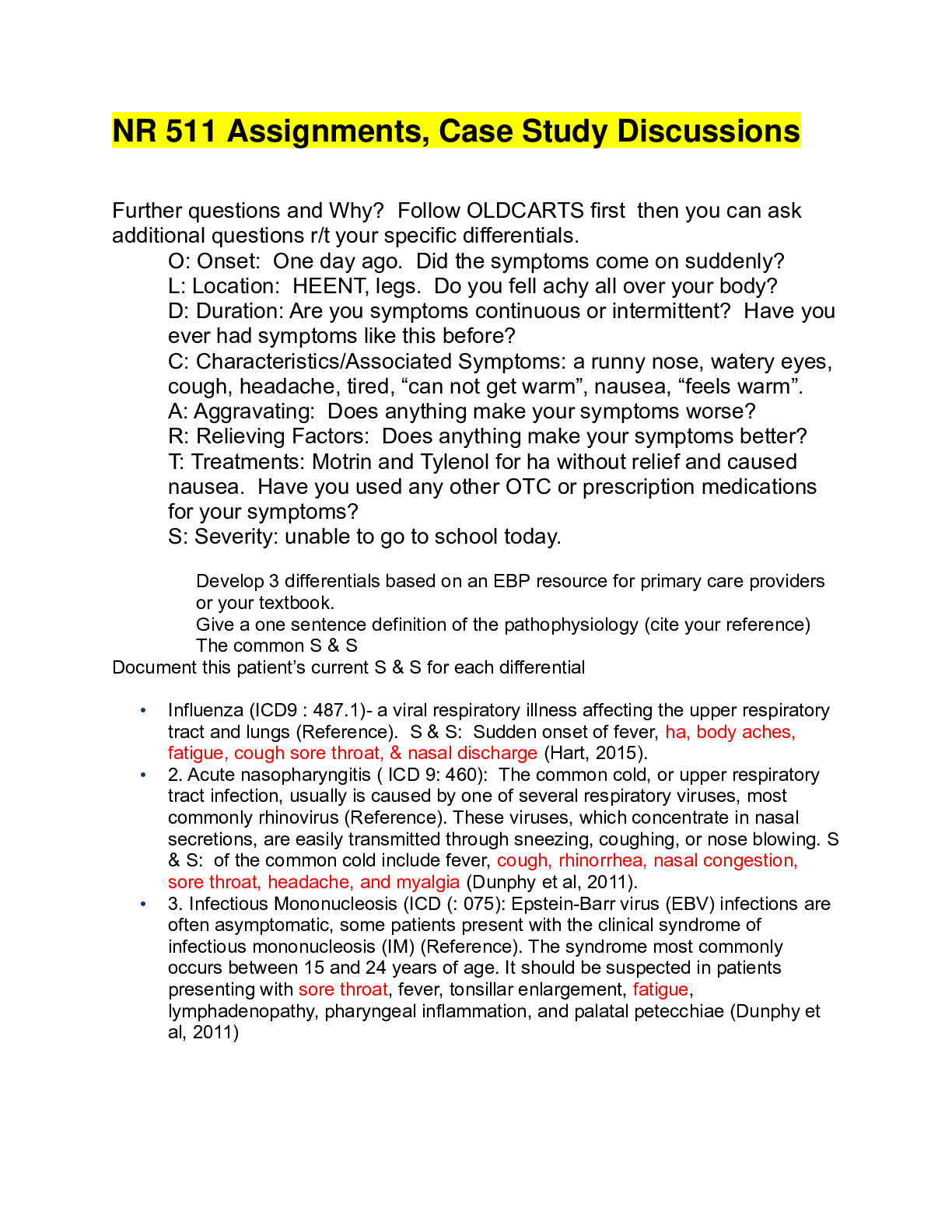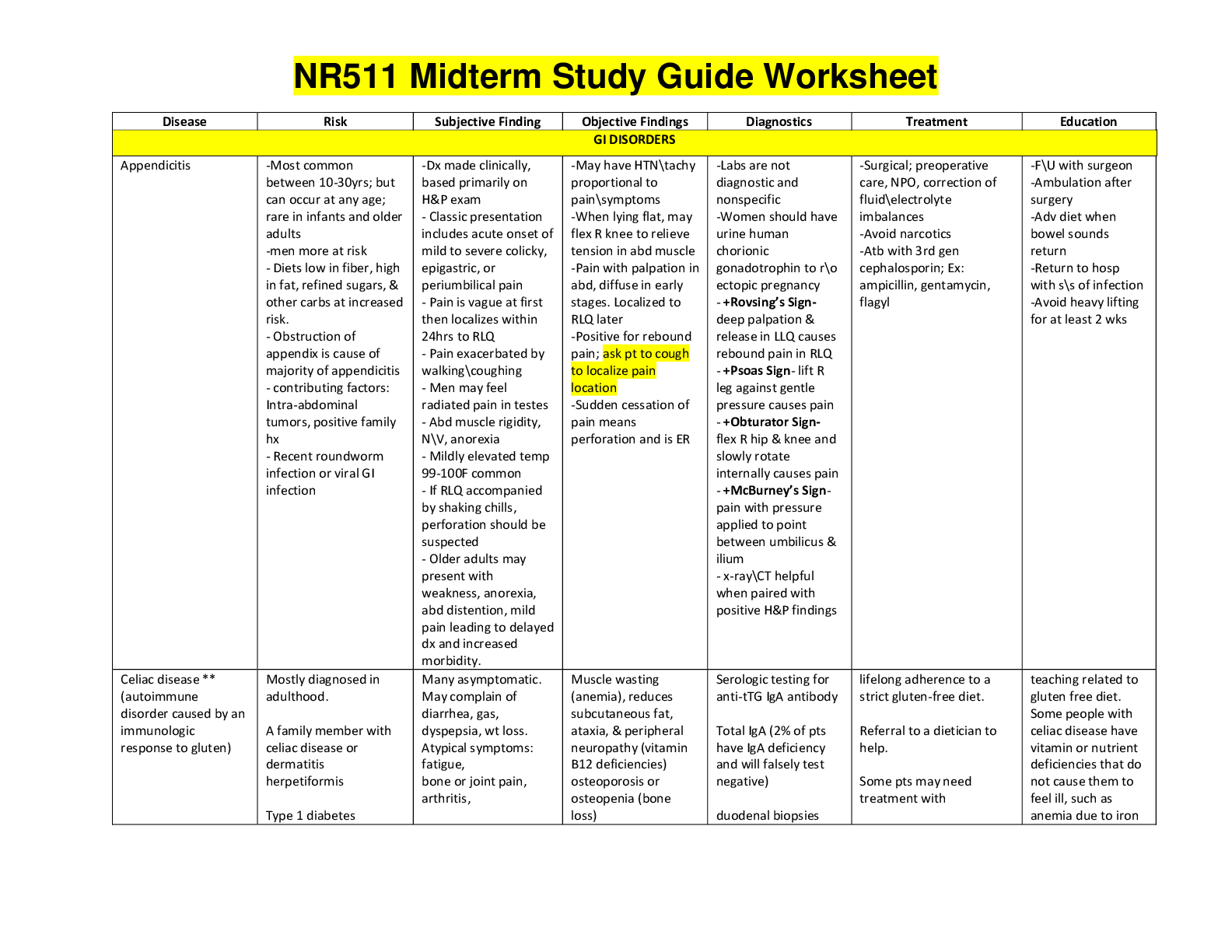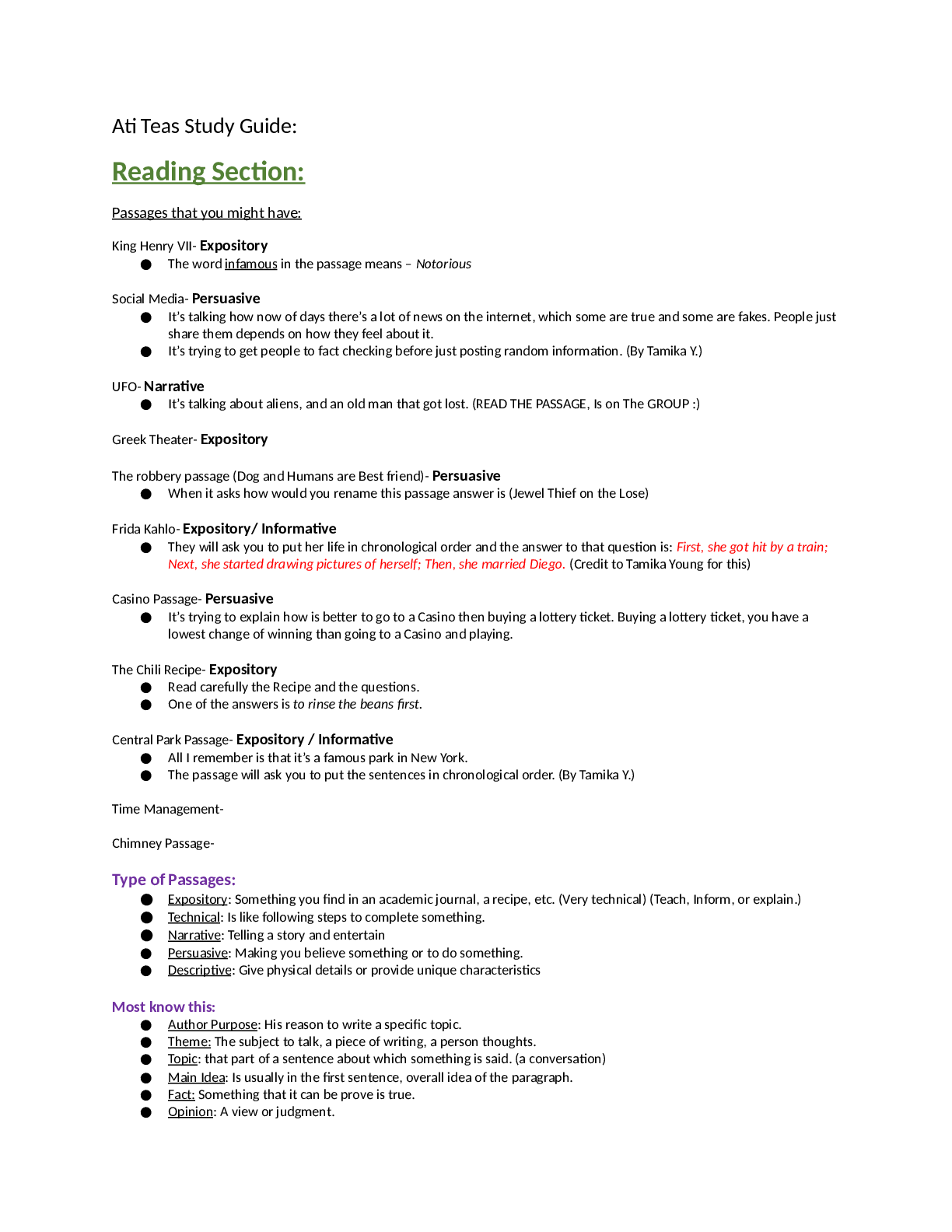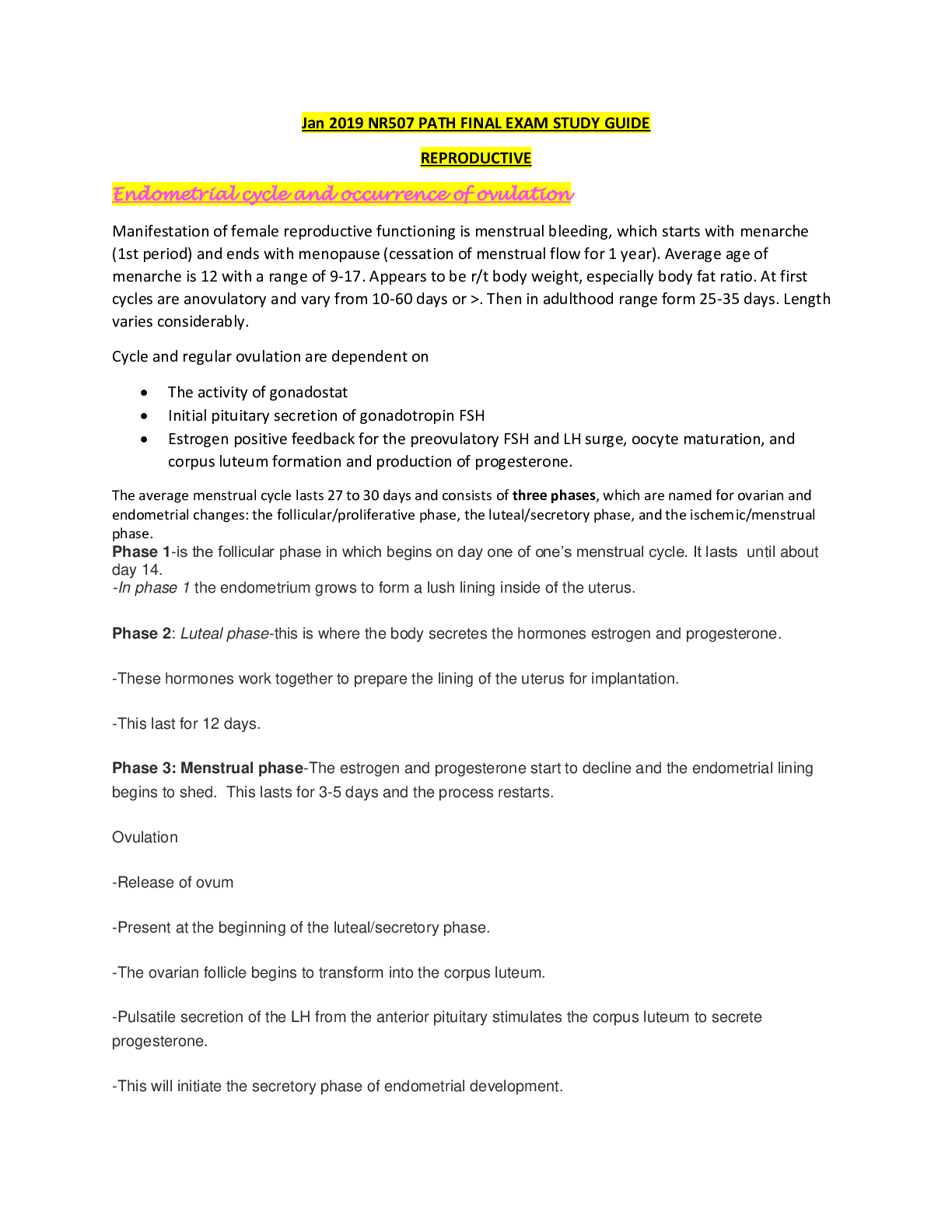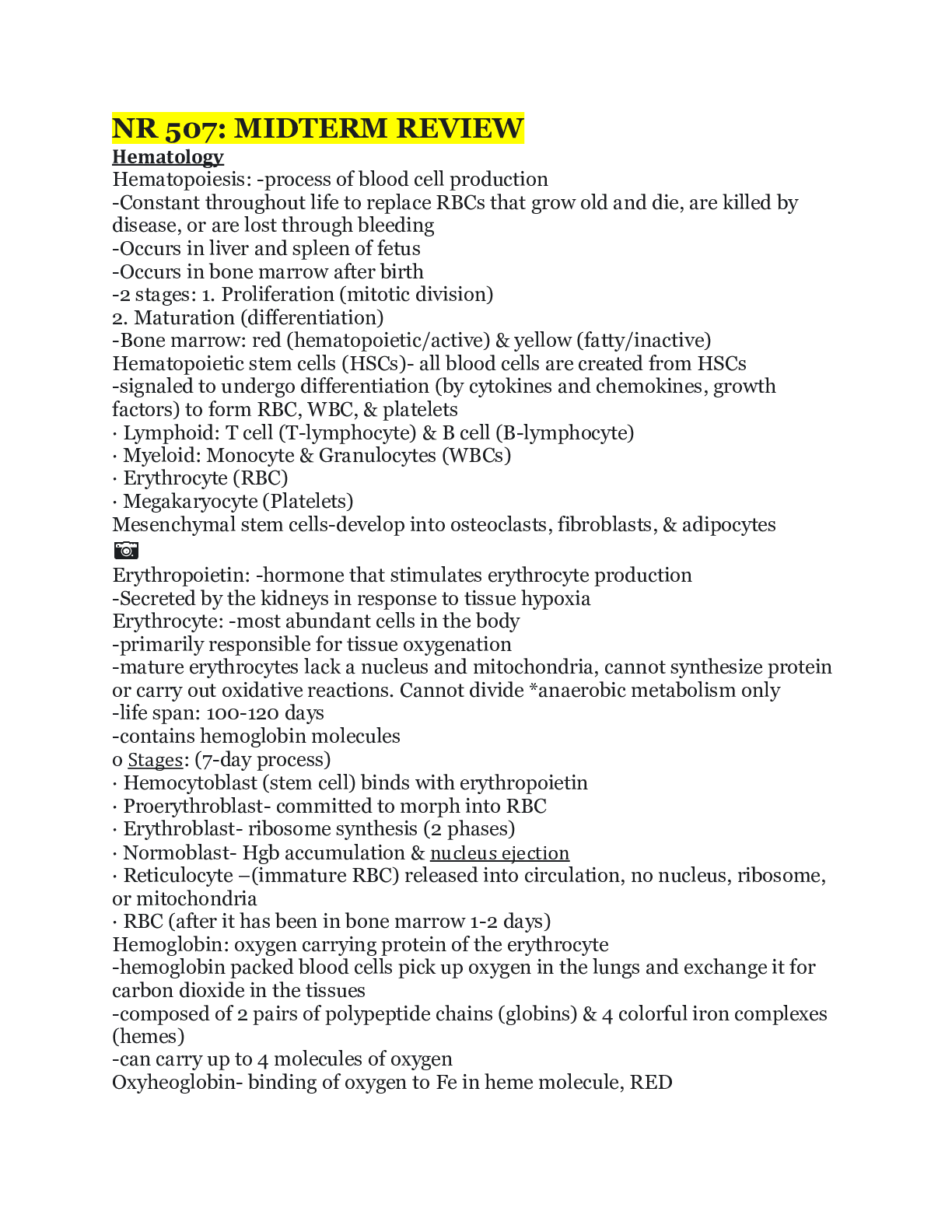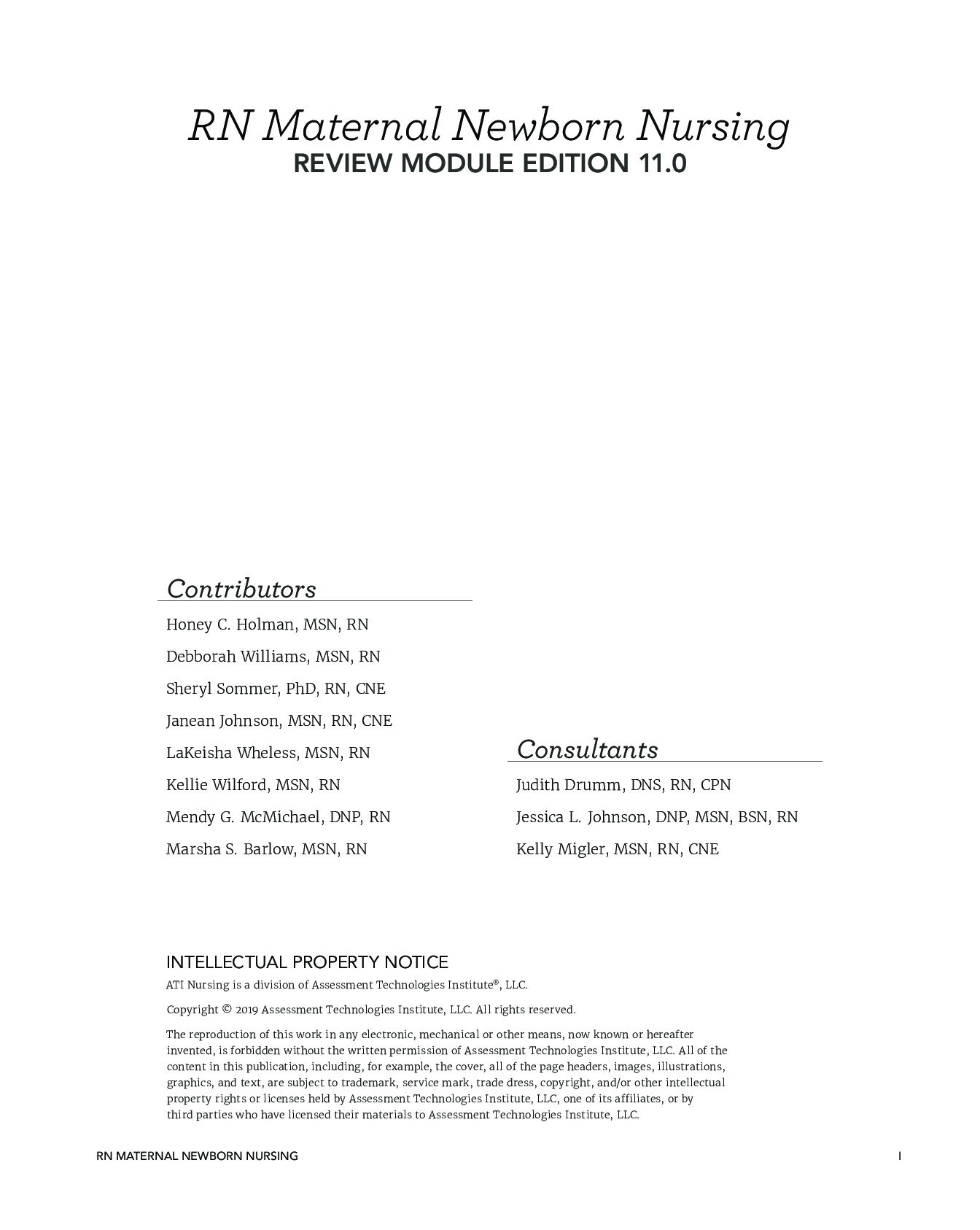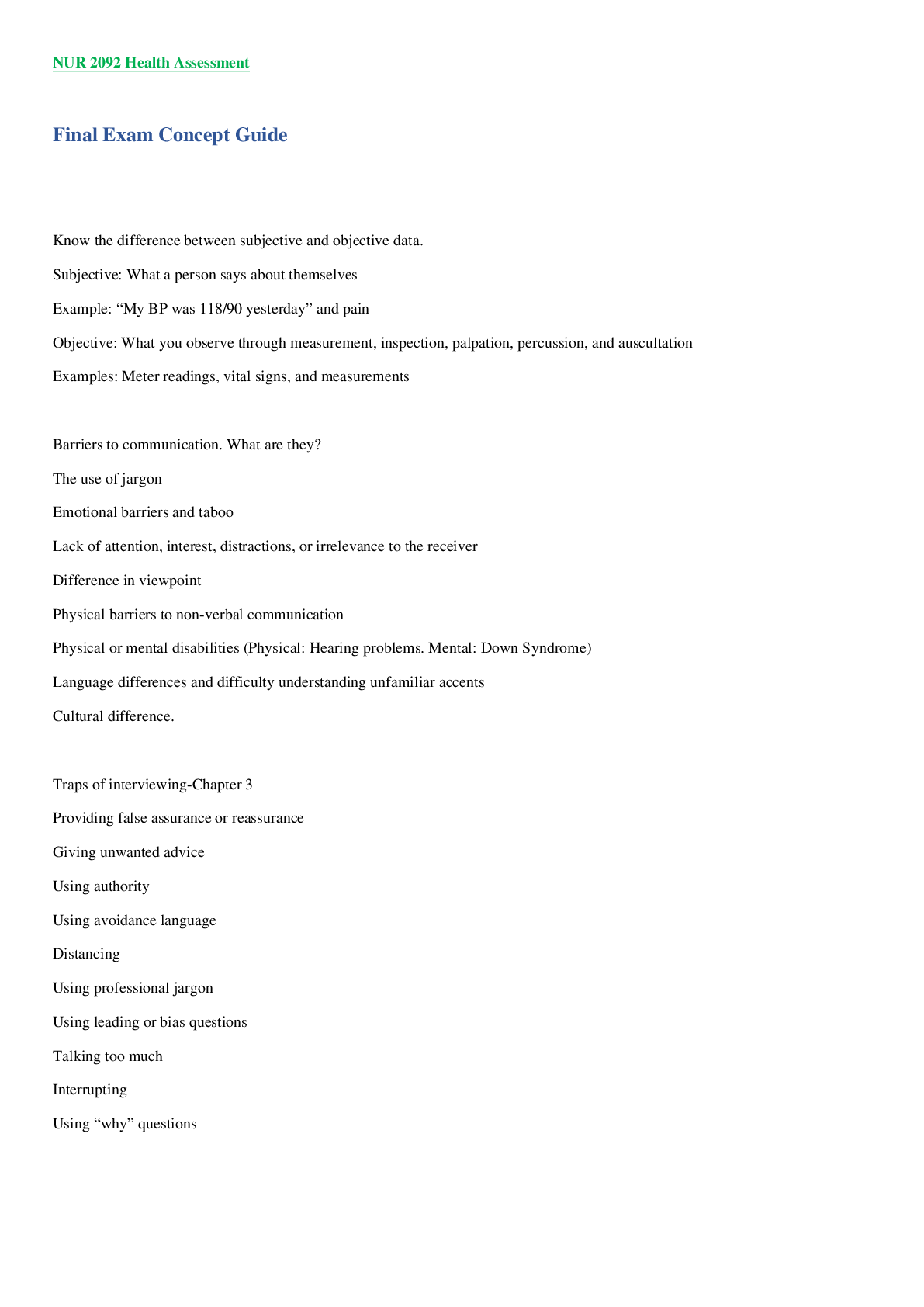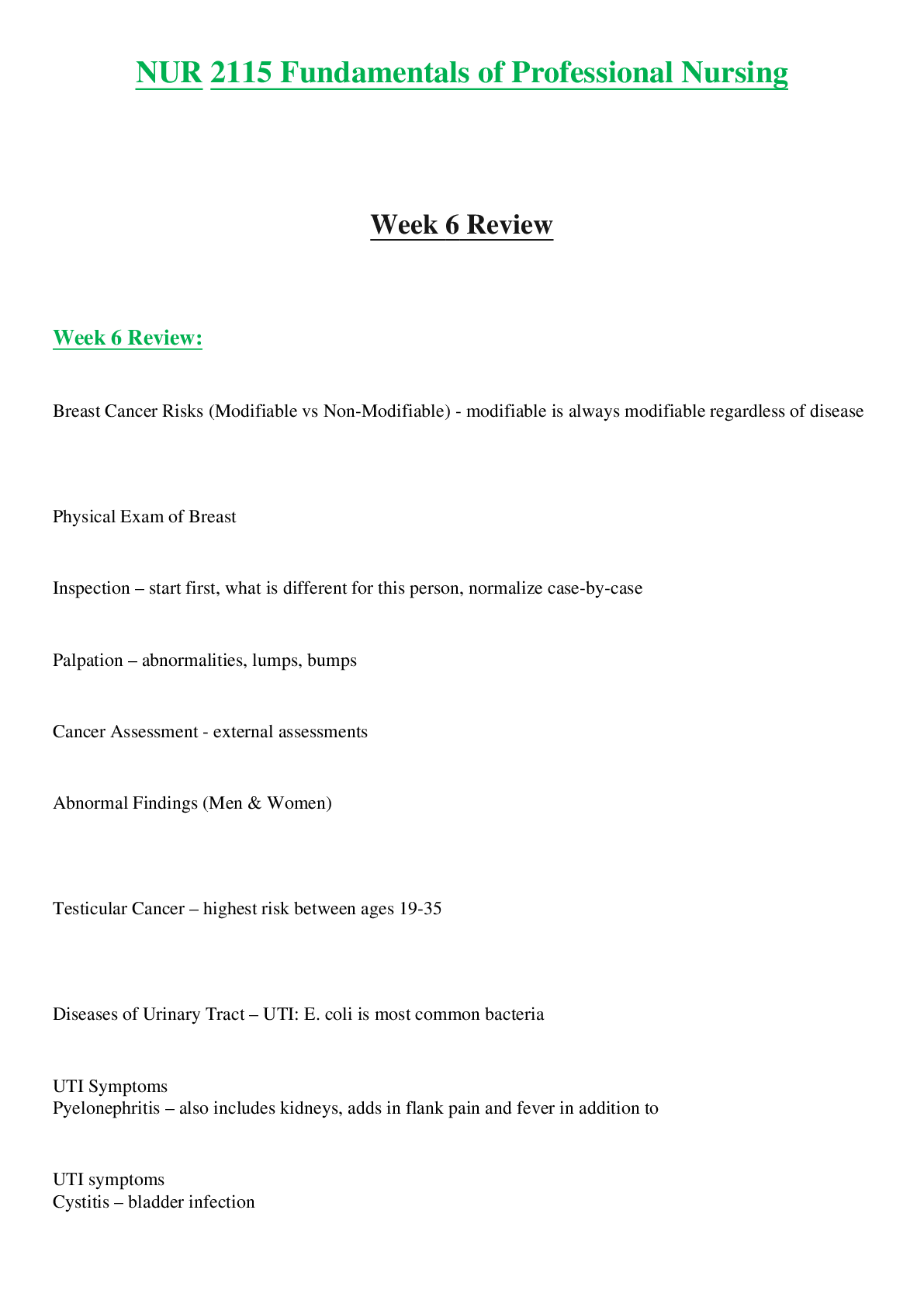Environmental Science > STUDY GUIDE > ENV 101 Introduction to Environmental Science Study Guide for Exam 2: Chapters 4, 5, 6 (All)
ENV 101 Introduction to Environmental Science Study Guide for Exam 2: Chapters 4, 5, 6
Document Content and Description Below
ENV 101 Introduction to Environmental Science Study Guide for Exam 2: Chapters 4, 5, 6 Chapter 4: 1. What is the difference in the adaptation of a sled dog's (such as a Husky) thick coat of ha ... ir to help it withstand the cold temperatures of Arctic winters and a dog that adapts to cold temperatures in the fall by growing a thickened coat? The adaptation of the sled dog best describes adaptation at the ____________ level while the dog exposed to seasonal colder temperatures has _____________. A. Regional; natural selection at the individual level B. Individual; physiological modifications at the population level C. Population; physiological modifications at the individual level D. Species; natural selection at the population level E. Ecosystem; physiological modifications at the individual level 2. Evolution occurs as a result of A. The discovery of a desirable characteristic in a population B. An individual's physiological modification C. Environmental change that forces modification in a resident species D. Better survival or reproduction rates by individuals with a particular characteristic E. A population's physiological modification 3. Which of the following is a physiological modification used to adapt to environmental conditions? A. Young saguaro seedlings sprouting under mesquites B. Leaves becoming thick and leathery on a plant growing in a dry, hot climate C. Locoweed growing only where selenium is present in soil D. Desert pupfish learning to deposit eggs where temperatures are optimal E. All of these are examples of physiological modifications used to adapt to environmental conditions 4. Natural selection will ultimately make a species A. More intelligent B. Physically bigger C. Better adapted to its environment D. More aggressive E. Less vulnerable to its predators 5. Regular lawn mowing selects for short-headed rather than tall-headed dandelions because A. Tall flowers spread their seeds farther B. Tall flowers cannot reproduce C. Short flowers can reproduce D. Short flowers spread their seeds farther E. Short flowers have less competition when the lawn is mowed often 6. Tolerance limits are _______ that limit a species' survival. A. Temperature ranges B. Any environmental conditions C. Population sizes D. Narrow salinity levels E. Undesirable toxin concentrations 7. A species can withstand a wide range of pH as an adult but the juveniles can only withstand a narrow range of pH. The abiotic factor, pH, would best be described as a A. Stress factor B. Intolerance factor C. Tolerance limit D. Critical factor E. Physical factor 8. Which of the following fish species would be the best indicator of clean, well-oxygenated water? A. Carp B. Largemouth bass C. Catfish D. Rainbow trout E. Sunfish 9. Populations are most critically limited by A. Available food B. Suitable shelter from the elements C. Available water D. Suitable shelter from predators E. Any of these, depending on the system 10. Indicator species, such as lichens, generally have a ___________ tolerance range for a ___________. A. Narrow; critical factor B. Narrow; number of physical factors C. Average; number of physical factors D. Broad; number of critical factors E. Broad; critical factor Use the following example: A species can withstand a narrow range of temperature. Above 100F there are no species present. In the range from 97F to 100F and 90F to 94F there are a few species present. Below 90F there are no species present. 11. What would you label the range of temperature from 90F to 94F for this particular species? A. Zone of intolerance B. Zone of physiological stress C. Tolerance limit range D. Optimal range E. Range of tolerance 12. What would you label the range of temperature from 95F to 96F for this particular species in the scenario? A. Zone of intolerance B. Tolerance limit range C. Zone of physiological stress D. Optimal range E. Range of tolerance 13. A generalist is a species that A. Occupies a large habitat range B. Occupies a variety of ecological niches C. Can reproduce under highly variable conditions D. Can reproduce only under specific conditions E. None of these are characteristics of a generalist species 14. Certain night-active moths and day-active birds are specialized nectar feeders. How do these species coexist if they are using the same resource for food? A. Because they both use the nectar, eventually one of the two species will need to move to a new area B. They do not compete for the nectar because they feed at different times of the day C. There is enough nectar to supply both the birds and the moths with their feeding needs D. Eventually the niche breadth will increase and there will be less competition E. None of the choices is correct 15. Humans can best be described as A. Occupying a narrow niche B. An example of convergent evolution C. Outside the rules of natural selection D. Specialists E. Generalists 16. Most organisms' niches are controlled by A. Genetic determinants B. Lessons learned from parents C. Behavior learned from others in their social groups D. Luck E. The predators and competitors they encounter 17. Resource partitioning leads species to A. Feed at different times B. Utilize slightly different prey C. Develop different physiological adaptations D. Live in slightly different regions E. All of these would be a result of resource partitioning 18. Resource partitioning tends to lead to a high degree of _______ in species. A. Specialization B. Evolution C. Convergent evolution D. Generalization E. Divergent evolution 19. Intraspecific competition is competition among ________ for resources. A. Predators and prey B. Both plants and animals C. Producers, consumers and detritivores D. Members of different species E. Members of a single species 20. Which of the following is not a common strategy for successful interspecific competition? A. Eating prey before they are "ready" (ripe) for other species B. Spreading seeds or offspring far and fast C. Producing substances that are toxic to competitors D. The life cycle of dragonflies (the larva live in the water) E. All of these are strategies for successful interspecific competition 21. An especially effective strategy for reducing intraspecific competition is A. Different ecological niches for juveniles and adults B. Rapid reproduction C. Eating prey before they are "ready" (ripe) for other species D. Resource partitioning E. None of these are examples for reducing interspecific competition 22. Symbiosis means A. A relationship in which both species benefit B. A parasitic relationship C. Commensalism D. Living together E. A relationship in which one species benefits and the other does not benefit 23. In the partnership of a lichen, the fungus provides _________ and the relationship is best described as _______. A. Most of the photosynthesis; symbiosis B. Poisons that deter predation; commensalism C. Structure and moisture-holding ability; mutualism D. Very little to the algal partner; parasitism E. Some of the photosynthesis; commensalism 24. A viceroy butterfly that closely resembles the bad tasting monarch is an example of __________ and the example of beetles that look like stinging wasps is an example of __________. A. Batesian mimicry; Batesian mimicry B. Batesian mimicry; Muellerian mimicry C. Muellerian mimicry; Muellerian mimicry D. Muellerian mimicry; Batesian mimicry E. Commensalism; symbiosis 25. A keystone species is a species whose presence A. Is the main reason a community exists B. Provides food for all other species in a community C. Is an indicator of environmental health D. Influences the population size of many other species in its community E. Is always at the top of the trophic levels as a top predator 26. In a commensal relationship, A. One species benefits while the other neither suffers nor benefits B. One species benefits while the other suffers C. Two species live together and both suffer D. Two species live together and neither benefits nor suffers E. Two species live together and both benefit 27. A biological community's productivity is a measure of A. Its number of species B. The number of individuals in the community C. Available solar energy that can be converted to biomass D. The amount of biomass produced in the community E. All of these are combined in measuring a community's productivity 28. "Abundance" describes the total number of _________ while "diversity" describes the number of _________. A. Species in a community; individual organisms in a community B. Organisms in a community; species in a community C. Individuals in a niche; niches available to a given species D. Species in a bioregion; trophic levels in a community E. Biomes; habitats available for different species 29. In a biological community where diversity is great, such as a tropical rainforest, the abundance of any one species is likely to be A. Great B. Small C. Widely variable from year to year D. The same from year to year E. None of these, abundance does not depend on diversity 30. As a rule, near the Earth's north and south poles, A. Diversity is high and abundance is low B. Abundance is high and diversity is high C. Neither abundance nor diversity is high D. Abundance is high and diversity is low E. Abundance and diversity are about the same 31. Complexity in an ecological community has to do with the number of A. Species in the population B. Species at each trophic level C. Genetic variations within a species D. Primary producers available E. Primary producers relative to the number of consumers 32. A community with hundreds of different types of primary producers, a few herbivores and only one carnivore, has A. Little complexity B. Little diversity C. A great deal of complexity D. Low productivity E. A great deal of productivity 33. A community that changes very little over time is said to have great A. Renewal ability B. Complexity C. Diversity D. Constancy E. Connectedness 34. In the coastal forest of Oregon an area was clear-cut for logging. Trees at the edge of the clearing and 200 meters into the forest died within a few months after the logging began. What is the best explanation for the death of the trees? A. The trees at the edge of the forest were more prone to disease B. Abiotic edge effects, such as increased herbivory, negatively affected the trees C. Increased sunlight, wind and temperature negatively affected the trees D. The roots of all of the trees were damaged E. Nitrogen fixing bacteria in the roots of the trees were killed 35. A "closed community" has a A. Narrow ecotone B. Gradual transition zone C. Wide ecotone D. Very small area E. Large core area 36. A climax community is one that A. Is relatively stable and long lasting B. Lasts forever C. Contains oaks or white spruce D. Is impervious to disruption E. Is adapted to periodic disruption 37. Primary succession occurs when a community develops ____________ while secondary succession occurs when one ________. A. Into a climax community; species replaces another B. And replaces another; ecosystem becomes stable C. On unoccupied ground; biological community replaces another D. And then fails; niche changes E. Intraspecific competition; experiences interspecific competition 38. As ecological development proceeds, a biological community A. Gradually stagnates B. Becomes more diverse C. Goes through repeated secondary succession stages D. Goes through repeated primary succession stages E. Becomes less complex 39. The most common reason that introduced species cause trouble is because they A. Are larger than native species B. Disrupt pre-existing niches C. Are unusually efficient predators D. Out compete the native species E. None of these is correct 40. Which of the following migrations is likely to cause the extinction of a native species? A. Migration of a member of a species of island birds to a large continent B. Migration of a pack of wolves to a nearby valley C. The introduction of a predator onto an island originally free from predators D. A seasonal move of large grazers that travel north in the summer and south in the winter E. The introduction of a new prey species onto an island originally free from this species Chapter 5: 41. A biome is described by A. A specified bioregion B. Broadly similar environmental conditions C. A watershed divide, generally D. Geographic location E. Large landforms in the area 42. Location of specific biomes can be predicted based on A. The Coriolis Effect B. The 2nd Law of Thermodynamics C. Precipitation and temperature D. Seasonal variations in sunspots E. Large landforms in the area 43. In the graph of precipitation and temperature, desert biomes would fall in the area marked by the letter A. A B. B C. C D. D E. E 44. Neo and Trinity are in a biome that has relatively stable temperatures and abundant rainfall. They have a graph of precipitation and temperature similar to the one shown. Which letter marks the biome they are located in? A. A B. B C. C D. D E. E 45. Cloud forests are found in ________ areas in tropical regions. A. Hot coastal B. Cool mountainous C. Cool plains D. Low elevation E. Valley 46. Neo finds himself sweating in a moist forest but there aren't many streams or wetlands. He is amazed by the tremendous amount of biodiversity including an abundance of biting mosquitoes. Has he inadvertently gotten closer to his goal of finding a boreal forest? A. Yes B. No - the description is that of a tropical seasonal forest C. No - the description is that of a temperate deciduous forest D. No - the description is that of a tropical rainforest E. No - the description is that of a temperate rainforest 47. A biome absent from North America is the A. Temperate deciduous forest B. Alpine tundra C. Desert D. Tropical rainforest E. Temperate rainforest 48. Which of the following is an example of a specialization that plants in the desert may have? A. Storing water in stems or roots B. Reducing water loss with thick epidermal layers C. Salt tolerance D. Storing water in stems or roots and reducing water loss with thick epidermal layers E. All of these are adaptations of plants living in desert conditions 49. Humid tropical forests have extraordinary biological diversity A. Because of the very fertile tropical soils B. Because rainfall dissolves soil nutrients and makes them available to plants C. Because water is not a limiting factor D. Despite a complete absence of nutrients in the environment E. Despite the poor, weathered soils 50. Tropical seasonal forests are specially adapted to tolerate A. Annual cycles of extreme heat and extreme cold B. Years of drought followed by years of rain C. Annual cycles of severe drought and heavy rain D. Extreme drought and cold at the same time E. Extreme heat 51. You are in an area that is relatively hot. You bend down and notice that there are tracks in the soil that are very old. Since you know that this area is easily destroyed by human activity and the harsh climate slows recovery from human damage you conclude that this biome is A. A tropical dry forest B. A desert C. Tundra D. A grassland E. A wetland 52. Morpheus, Trinity and Neo are on the wet western coast of North America and as they look around they see lots of mosses, lichens and ferns covering the tree branches. Condensation from fog on the leaves is a major form of precipitation. Where are they? A. Temperate rainforest B. Boreal forest C. Tropical rainforest D. Southern pine forest E. Tropical savannah 53. Deciduous forests A. Are adapted to extremely cold climates B. Have trees that bear seeds in cones C. Have trees that shed their leaves seasonally D. Are not useful commercially E. Are not found in the African continent 54. Many people in the United States take trips in the spring to see annual flowers that grow and flower before they are shaded by canopy. Where are these people going? A. Deserts after winter rain showers B. Prairies or grasslands C. Tropical rainforests D. Temperate deciduous forests E. Boreal forests 55. Boreal forests are generally A. Cold and dry, with extensive barren areas B. Warm and humid, with large rivers C. Dry because water is frozen most of the year D. Slow-growing because of the cold temperatures E. Soggy in the summer because of permafrost 56. Morpheus has been led into a wilderness environment and left to fend for himself for the summer. Luckily, he has a good coat because it looks like there may be a frost during the night and the mosquitoes are everywhere. As he looks around, he is relieved because he recognizes some of the plants. There are some mosses, lichens, small shrubs, sedges and grasses. Which biome is he in? A. Tropical rainforest B. Wetland C. Temperate rainforest D. Tundra E. Coastal area 57. The biome type that has a short growing season and is summer feeding and breeding grounds for caribou and musk-ox is the A. Temperate grasslands B. Bog or fen C. Boreal forests D. Arctic tundra E. Arctic deserts 58. Mangrove trees are found along ________________ shorelines. A. Tropical freshwater B. Tropical saltwater C. Temperate freshwater D. Temperate saltwater E. Tropical and temperate saltwater 59. Which of the following protects mainland shores form the force of waves? A. Wetlands B. Barrier islands C. Coral islands D. Estuaries E. Volcanic islands 60. Freshwater ecosystems A. Lack oxygen B. Lack carbon dioxide C. Include lakes, marshes, bogs and fens D. Do not contain thermoclines E. Are not affected by nutrient availability 61. What environmental factor does not change between "b" and "e" in the diagram? A. Light penetration B. Temperature C. Nutrient availability D. Oxygen content E. All of these change between "b" and "e." 62. Oxygen levels are lowest in what section in the diagram? A. A B. B C. C D. D E. E 63. What aquatic ecosystem phenomenon is illustrated in the diagram? A. Nutrient inputs from upstream and uphill B. Vertical stratification C. Nutrient cycling D. Internal convective currents E. Horizontal stratification 64. The thermocline is the layer in a lake at which A. Pollutants are trapped and held B. Seasonal lake mixing occurs C. The warm upper zone meets the cold lower zone D. Nutrient levels are the lowest E. Light no longer penetrates enough for photosynthesis to occur 65. Wetlands are biomes that A. Are wet all year round B. Are wet at least some of the year C. Have fresh, not salty, water D. Receive more rainfall than other ecosystems E. Have salty, not fresh water 66. The biome type that has lost the greatest percentage of its original area due to human activities is the . Temperate conifer forest B. Tropical rainforest C. Temperate deciduous forest D. Temperate grassland E. Tropical grassland 67. Estuaries are noted by biologists because they have few, but highly specialized, biological niches. True False 68. Wetlands perform a major ecosystem service of trapping and filtering water as it passes through the wetland area. True False 69. Arctic deserts and tundra are the least disturbed by humans since they are usually unattractive places for humans to live. True False Chapter 6: 70. An organism's biotic potential is the maximum number of offspring A. That survive to adulthood B. Its habitat can support C. It produces at one time D. It actually produces over its lifetime 71. In the real world, many factors determine the numbers of organisms in any one population. Yet, a "superfly" with unlimited food and no mortality would show what type of growth? A. Carrying capacity geometric increase B. Irruptive growth C. Exponential growth D. Logistic growth E. Malthusian growth 72. In cases of exponential growth rates, a population ________ each year. A. Increases at the same rate B. Is multiplied by a constant number C. Doubles D. Triples E. Increases by a constant number (one, ten, one hundred, etc.), depending on the system 73. Which of the following sequences is an example of exponential growth rate? A. 2, 4, 8, 16 B. 1, 2, 4, 6 C. 1, 3, 5, 7 D. 3, 13, 23, 33 E. All of these sequences are examples of geometric growth rate 74. A population growing at 1 percent per year should double in about ___ years. A. 30 B. 70 C. 10 D. 2 E. 0.7 75. The doubling time for a population with an annual growth rate of 0.07 is A. 1 year B. 5 years C. 10 years D. 50 years E. 100 years 76. Carrying capacity is the population A. That an environment can support in an optimal year B. Of a species that an environment can support on a long-term basis C. That remains after a catastrophic dieback has occurred D. Of a species without limiting factors E. Of a species without predators 77. In the real world, population explosion is usually followed by A. Continuous high population levels B. A gradual decrease in population as food supplies dwindle C. A tremendous increase in genetic diversity D. A gradual increase in population due to the availability of mates E. A population crash 78. A dieback or population crash, often occurs after a species ________ its environmental carrying capacity. A. Meets B. Undershoots C. Overshoots D. Oscillates around E. Decreases 79. An island has formed off the coast of the Pacific Northwest. The Department of Natural Resources (DNR) has determined that there is enough land area for a herd of 100 elk, yet they say the carrying capacity is only 60 elk. This inequality can best be explained by the fact that the A. DNR is probably being careful not to overestimate B. DNR must have added up the environmental resistance incorrectly C. Elk population will probably fluctuate between 60 and 100 animals D. Physical factor of space is only one of the determiners for population size in a community E. Law of limiting factors determines the maximum growth rate for a given population 80. Logistic growth rates are those in which a population A. Grows very slowly when conditions are good and when conditions are not optimal B. Grows rapidly when conditions are good, then slows as it approaches carrying capacity C. Overshoots and dies back repeatedly D. Remains significantly below carrying capacity E. Grows at a constant rate of increase per unit time 81. The ability to produce rapid population overshoots can be a useful strategy for a species that tends to A. Colonize new territory B. Maintain a firm position in its current habitat C. Be part of a climax community D. Develop intricate niche relationships E. Be part of a complex ecosystem 82. Which of the following types of population curves would best represent a group of elephants that enter a new, open habitat and become a stable part of that ecosystem? A. Norm-shaped curve B. S-shaped curve C. J-shaped curve D. Cyclic oscillation-shaped curve E. Survivorship curve 83. You are studying an organism that is a pioneer species is an opportunist and does not care for its offspring. This organism probably has a _________________ population growth strategy. A. K-adapted B. R-adapted C. Irregular D. Catastrophic E. R-adapted and irregular 84. You are studying an organism that is fairly large, matures slowly, lives fairly long and cares for its offspring. This organism probably has a _________________ population growth strategy. A. K-adapted B. R-adapted C. Irregular D. Catastrophic E. R-adapted and irregular 85. An organism with ___________ "strategies" would be considered to have __________ natality. A. K-adapted; high B. R-adapted; high C. K-adapted; low D. R-adapted; low E. R-adapted; high AND k-adapted; low 86. Natality is usually A. Constant in a population B. Constant for a species C. Constant in an ecosystem D. Variable, depending on the number of recent deaths E. Variable, depending on environmental conditions 87. The term "fecundity" refers to an organism's ____________ while fertility is ______________. A. Physical ability to reproduce; actual number of offspring produced B. Actual number of offspring produced; physical ability to reproduce C. Average life span; physical ability to reproduce D. Replacement level of reproduction; actual number of offspring produced E. Physical ability to reproduce; replacement level of reproduction 88. Life expectancy is the A. Maximum life span that an individual of a given species could reach B. Number of individuals in a population that survive in a given year C. Number of years an individual of a certain age will probably live D. Probability that an individual will survive infancy E. All of these are descriptions of life expectancy 89. Survivorship is determined by A. The percentage of a cohort that survives to a certain age B. Number of individuals in a population that survive in a given year C. Number of years an individual of a certain age will probably live D. Probability that an individual will survive infancy E. Maximum life span that an individual of a given species could reach 90. The longest period of life that a given type of organism can reach is known as A. Survivorship B. Life span C. Life expectancy D. Mortality E. Fecundity 91. If there is no migration, the size of a population is limited solely by interaction between A. Natality and fertility B. Mortality and fecundity C. Mortality and survivorship D. Natality and mortality E. Life expectancy and survivorship 92. Predation is considered to be a(n) _______________ factor. A. Extrinsic B. Intrinsic C. Abiotic D. Biotic E. Extrinsic and biotic 93. Which of the following is an abiotic population control mechanism? A. Predation B. Disease C. Water shortages D. Prey shortages E. Competition 94. Which of the following is a biotic population control mechanism? A. Nutrients B. Precipitation C. Day length D. Climate E. Pathogens 95. In general, abiotic regulatory factors tend to be ___________ while biotic factors tend to be _____________. A. Interspecific; intraspecific B. Intraspecific; interspecific C. Density-dependent; density-independent D. Density-independent; density-dependent E. Interspecific; density-independent 96. Which of the following is an intraspecific interaction? A. Mutualism B. Territoriality C. Parasitism D. Predation E. All of these are examples of intraspecific interactions 97. How does island biogeography apply to ecosystems other than islands? A. Relatively rare ecosystems such as coastal areas are more stable if they have high species diversity B. Habitats that are large and close to development are more adversely affected than smaller fragmented habitats C. Habitat fragmentation has formed islands of habitat in "oceans" of development D. Along with islands in oceans and lakes, the principles of island biogeography apply only to wetland areas E. Island biogeography is only concerned with islands in oceans and lakes 98. Genetic diversity is lost in a small population when A. The ecological diversity is high B. Genetic mutations cause some individuals in a population to be different in coloration or size C. Individuals from other populations are introduced into the population and the genes are diluted D. Only a few individuals survive a catastrophe E. Genetic mutations cause most individuals in a population to have similar genetic makeup 99. White-tailed deer populations are at about the same levels as they were a century ago. True False 100. Your favorite class is A. ENV 101 B. ENV 101 C. ENV 101 D. ENV 101 E. All of the above ENV 101 Chapters 4, 5, 6 Key Terms and Concepts Adaptation – the acquisition of traits that allow a species to survive in its environment natural selection – process of better-selected individuals passing their traits to the next generation selection pressures – the environment gives certain mutations an advantage under particular conditions and causes other variants to be disadvantaged species limits critical factor – single factor in shortest supply relative to demand; determines where a species lives tolerance limits – environmental factors with min and max levels beyond which a species can not survive or reproduce indicators – the presence or absence of species habitat- the place or set of environmental conditions in which a particular organism lives ecological niche- role played by a species in a biological community and set of environmental factors that determine distribution endemic- species who only occur in one area exclusion principle- no two species can occupy the same ecological niche at the same time. The one who is more efficient at using the resource will exclude the other. resource partitioning- species exploit resources differently speciation – development of a new species geographic isolation- barrier where they are genetically isolated from each other allopatric speciation- speciation from geographic isolation sympatric speciation- speciation that occurs within one geographic area taxonomy – study of types of organisms and their relationships binomials- genus species names. Identify and describe species using latin intraspecific competition- competition among members of the same species interspecific competition- competition between members of different species coevolution- overtime predator and prey evolve on response to one another Batesian mimicry- harmless species mimic the warning coloration of harmful species to grain protection Mullerian mimicry- 2 harmful species evolve to look alike Symbiosis- 2 or more species the live intimately together with often enhancement of survival Mutualism- both organisms benefit Commensalism- one member benefits while the other neither benefits nor is harmed Parasitism- a form of predation, dependency of the parasite on its host keystone species- plays a critical role in a biological community that is out of proportion to its abundance primary productivity- the rate of biomass production abundance- total number of organisms in a biological community diversity- a measure of the number of different species, ecological niches, or genetic variation present ecological structure- patterns of spatial distribution of individuals and populations within a community; random, clustered, uniform complexity- number of species at each trophic level and the number of trophic levels in a community edge effects- important aspects of community structure is the boundary between one habitat and another ecotones- boundaries between adjacent communities primary succession- a community begins to develop on a site previously unoccupied secondary succession- an existing community is disrupted and a new one develops pioneer species- the first colonists, hardy disturbance- any force that disrupts the established patterns of species diversity and abundance, community structure, or community properties disturbance-adapted species biomes- areas sharing similar climate, topographic and soil conditions, and thus the same type of biological communities broadly speaking terrestrial ecosystems vertical zonations- vegetation types change rapidly from warm and dry to cold and wet – vegetation zones defined by altitude cloud forests- high in the mountains where fog and mist keep vegetation wet all the time tropical rainforests – rainfall is abundant and temps are warm-hot all year round tropical seasonal forests- wet and dry seasons with hot temperatures year round grasslands- too little rainfall to support forest; prone to fires in dry season savannas- grassland with sparse tree cover deserts- rare and unpredictable precipitation; venerable chaparral- war, dry summers and cool, moist winters (Mediterranean/temperate shrubland) deciduous- broadleaf forests with plentiful rainfall and lose leaves in winter coniferous- moisture is limited temperate rainforest- cool, rainy forest often enshrouded in fog boreal forest- northern forests, coniferous taiga- edge of boreal forest, extreme cold and short summers tundra- treeless landscape at high latitude marine ecosystems phytoplankton- free-floating photosynthetic plants that support a marine food web coral reefs- aggregations of coral polyps that live symbiotically with algae. Calcium rich skeletons build up reef algal photosynthesis coral bleaching- expel algal partners and die due to warming costal zones- vary with depth, light, nutrient concentrations, and temperature mangroves- trees that grow in salt water barrier islands- low, narrow, sandy islands that form parallel to a coastline estuaries- bays where rivers empty in the sea, mixing fresh water with salt water freshwater ecosystems thermocline- sharp temperature boundary between layers littoral zone wetlands- shallow ecosystems in which the landsurface is saturated or submerged at least [art pf the uear swamps,- wetlands with trees bogs- areas of saturated ground marshes- wetlands without trees fens- similar to bogs but fed by groundwater human disturbance (of biomes) biotic potential- unrestrained biological reproduction exponential growth- growth at a constant rate with no limit J curve carrying capacity- number of species that can be in a certain area without depleting resources population overshoot- population exceeds that carrying capacity of the environment and death rates rise as resources become scarce population crash- rapid dieback from shortages of food or other resources boom-and-bust cycles’ – population undergoes repeated cycles of overshooting and then crashing logistic growth- growth rates regulated by internal and external factors until coming into equilibrium with environmental resources density dependent factors- as population size increases, the effect intensifies r-selected species- high reproductive rates, low parental care K-selected species- slow growth as the carrying capacity of their environment is approached, high parental care Natality – production of new individuals Fecundity- physical ability to reproduce Fertility- measure of actual number of offspring produced Survivorship- percentage of cohort surviving to a certain age Mortality- death rate life expectancy- probable number of years of survival for an individual of a given age life span- longest period of life reached by a given type of organism emigration- movement of members out of a population biotic factors- caused by living organisms, density dependent abiotic factors- caused by non-living environmental components. Density independent and don’t regulate the population interspecific interactions- between species intraspecific interactions- competition for resources by individuals within a population stress-related diseases conservation biology island biogeography- small islands far from a mainland have fewer terrestrial species than larger, closer islands. Balance of colonization and extinction conservation genetics genetic drift- change in gene frequency due to random event founder effect demographic bottleneck- just a few members of a species survive a catastrophic event such as a natural disaster minimum viable population size- minimum population size required for long-term survival of a species meta-population- a collection of populations that have regular or intermittent gene flow between geographically separate unites [Show More]
Last updated: 3 years ago
Preview 1 out of 19 pages

Buy this document to get the full access instantly
Instant Download Access after purchase
Buy NowInstant download
We Accept:

Reviews( 0 )
$15.00
Can't find what you want? Try our AI powered Search
Document information
Connected school, study & course
About the document
Uploaded On
Aug 12, 2020
Number of pages
19
Written in
All
Additional information
This document has been written for:
Uploaded
Aug 12, 2020
Downloads
0
Views
213

